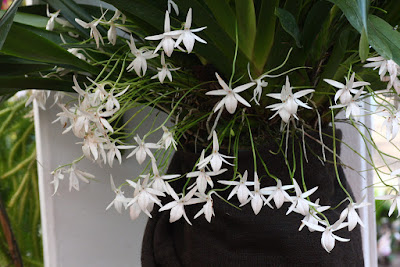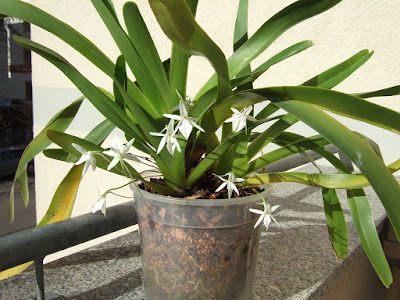Jumellea arachnantha is found on the Comoros Islands, where it is endemic to Grande Comoro Island in forests at elevations of 1200 to 1800 meters.
Jumellea arachnantha also called as The Spider Flowered Jumellea, Aeranthes arachnanthus, Mystacidium arachnanthus, is a species of the genus Jumellea. This species was described by Friedrich Richard Rudolf Schlechter in 1915.
IDENTIFY JUMELLEA ARACHNANTHA ORCHID PLANT
Jumellea arachnantha is found on the Comoros Islands, where it is endemic to Grande Comoro Island in forests at elevations of 1200 to 1800 meters.
It is a medium sized, warm to cool growing epiphyte with a short to no stem carrying, acutely folded, erect to spreading, linear to oblong-ligulate, bilobed apically leaves held in a fan-shape.
The Spider Flowered Jumellea blooms on several, 20 cm long, axillary, erect, single flowered inflorescence with 3 to 4 cucullate, basal sheaths arising in the late spring. The flowers are pure white, pleasantly fragrant, and last about 1 month.
JUMELLEA ARACHNANTHA ORCHID PLANT CARE AND CULTURE
Cultural information should only be used as a guide, and should be to be adapted to suit you. Your physical location; where you grow your plants, how much time you have to devote to their care, and many other factors, will need to be taken into account. Only then can you decide on the cultural methods that best suit you and your plants.
Light:
Jumellea arachnantha needs a light level of 10000-20000 lux. Light should be relatively low and filtered or diffused. Light is not a critical factor when growing these plants, but their leaves will burn if exposed to 50% sunlight. Strong air movement should be provided at all times.
Temperature:
Summer days temperature at average 23-24°C, and nights temperature at average 17°C, with a diurnal range of 6-7°C.
Humidity:
The Spider Flowered Jumellea need the humidity of 80-85% most of the year, dropping to near 75% for a month or so in late winter.
Substrate, growing media and repotting:
Jumellea arachnantha are usually grown in pots or baskets filled with a potting mix of medium to coarse fir bark. The mix should be open and fast-draining to allow good aeration, since the roots cannot tolerate stale or soggy conditions.
Plants may also be grown mounted to a piece of bark or a log with a pad of sphagnum around the roots. If plants are mounted, high humidity must be maintained and plants need to be misted at least once a day in summer. Several mistings a day may be necessary for mounted plants during extremely hot, dry weather.
Plants should be repotted before the medium breaks down, preferably when new root growth is just starting. This allows the plant to become established in the shortest possible time with the least amount of stress.
Watering:
Rainfall occurs from late spring into autumn. Amounts diminish rather rapidly into a 4-5 months dry season that lasts until the following spring. Rainfall may be greater than indicated in the mountain habitat. Cultivated plants should be watered often while actively growing, but drainage should be excellent.
Fertilizer:
1/4–1/2 recommended strength, applied weekly when plants are actively growing. You can use a balanced fertilizer throughout the year; but others use a high-nitrogen fertilizer from spring to midsummer, then switch to one high in phosphates in late summer and autumn.
Rest period:
Winter days temperature at average 19-20°C, and nights average 14-16°C, with a diurnal range of 5-6°C. In winter, water should be reduced for Jumellea arachnantha plants which should become somewhat dry between waterings, but they should never be allowed to dry out completely. If grown under very cool conditions, however, plants should be kept quite dry. Fertilizer should be reduced or eliminated until new growth starts and heavier watering is resumed in spring.















COMMENTS